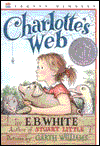Charlotte's Web

Spotlight on the popular children's book
by Holly Hartman
 Related Links |
Charlotte's Web—the best-selling children's paperback of all time—was described by its author as "a story of friendship and salvation on a farm." If you've already read the book, you know about the friendship that grows between Wilbur, a runty pig, and Charlotte, a heroic spider. But you may not know that the book's author, E. B. White, was himself a friend to animals.
Barnyard Smells
White researched every detail that went into his three books for children: Stuart Little (1945), Charlotte's Web (1952), and The Trumpet of the Swan (1970). For Charlotte's Web the research was close to home—at White's own farm in Maine.
As a result, the barnyard of Charlotte's Web seems real in every detail, and so do the habits of its animals. Despite Charlotte's sophisticated vocabulary, she is still a spider who traps flies in her web and sucks their blood. Likewise, though Wilbur expresses deep emotions, he is still a pig who likes to lie in the mud and breathe in the warm smell of manure.
DARKNESS SETTLED over everything. Soon there were only shadows and the noises of the sheep chewing their cuds, and occasionally the rattle of a cow-chain up overhead. You can imagine Wilbur's surprise when, out of the darkness, came a small voice he had never heard before. It sounded rather thin, but pleasant. "Do you want a friend, Wilbur?" it said. "I'll be a friend to you. I've watched you all day and I like you." —Charlotte's Web |
Saving a Pig's Life
In Charlotte's Web, a spider saves a pig from slaughter. In real life, the author had tried to save a pig—and failed. A few years before Charlotte's Web, White wrote an essay about caring for a dying pig at his farm. Even though White had raised the pig to make bacon, at the end he found himself desperately trying to save the pig's life, "cast suddenly in the role of pig's friend and physician."
Although farm pigs are, in a sense, born to die—being destined for the butcher—White had always had mixed feelings about this fact of farm life. "One day when I was on my way to feed the pig, I began to feel sorry for the pig because, like most pigs, he was doomed," he recalled. "This made me sad. So I started thinking of ways to save a pig's life." Soon the story of Wilbur was born.
Inspired by Spiders
Charlotte A. Cavatica, the heroine of the book, was also born of observations in White's barn. "I had been watching a big, gray spider at work and was impressed by how clever she was at weaving," he remembered. But what would happen if a clever spider could weave not only webs, but words? Charlotte's Web explores this possibility.
A Change of Scene
During the 1920s, White was a successful essayist and poet in New York City. In 1939, however, he moved with his family to a farm in quiet North Brooklin, Maine. "I can't claim to be a real farmer," White said, "but we do farm and I like to work outside." The Whites had sheep, chickens, and pigs, as well as rambling gardens.
Surrounded by mountains and sea, White lived on his farm until he died in 1985. He wrote his children's novels at an old typewriter in ths boathouse. When not writing or doing farm chores, White would ride his bike long distances, even in bad weather.
The Life of the Imagination
In a letter to a young reader, White wrote:
"in real life, a spider doesn't spin words in her web . . . But real life is only one kind of life—there is also the life of the imagination. And although my stories are imaginary, I like to think that there is some truth in them, too—truth about the way people and animals feel and think and act."
- More on Books
